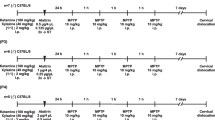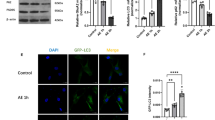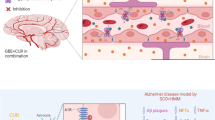Abstract
Huntington’s disease (HD) is a progressive neurodegenerative and hyperkinetic movement disorder. Decreased activity of cAMP-responsive element-binding protein (CREB) is thought to contribute to the death of striatal medium spiny neurons in HD. The present study has been designed to explore the possible role of roflumilast against qunilonic acid (QA) induced neurotoxicity in rats intending to investigate whether it inhibits the neuroinflammatory response through activation of the cAMP/CREB/BDNF signaling pathway. QA was microinjected (200 nmol/2 µl, bilaterally) through the intrastriatal route in the stereotaxic apparatus. Roflumilast (0.5, 1, and 2 mg/kg, orally) once-daily treatment for 21 days significantly improved locomotor activity in actophotometer, motor coordination in rotarod, and impaired gait performance in narrow beam walk test. Moreover, roflumilast treatment significantly attenuated oxidative and nitrosative stress (p < 0.05) through attenuating lipid peroxidation nitrite concentration and enhancing reduced glutathione, superoxide dismutase, and catalase levels. Furthermore, roflumilast also significantly decreased elevated pro-inflammatory cytokines like TNF-α (p < 0.01), IL-6 (p < 0.01), IFN-γ (p < 0.05), NF-κB (p < 0.05) and significantly increased BDNF(p < 0.05) in the striatum and cortex of rat brain. The results further demonstrated that roflumilast effectively increased the gene expression of cAMP(p < 0.05), CREB(p < 0.05) and decreased the gene expression of PDE4 (p < 0.05) in qRT-PCR. These results conclusively depicted that roflumilast could be a potential candidate as an effective therapeutic agent in the management of HD through the cAMP/CREB/BDNF signaling pathway.










Similar content being viewed by others
References
Adil M, Mansoori MN, Singh D et al (2017) Pioglitazone-induced bone loss in diabetic rats and its amelioration by berberine: a portrait of molecular crosstalk. Biomed Pharmacother 94:1010–1019. https://doi.org/10.1016/j.biopha.2017.08.001
Ansari MN, Ganaie MA, Rehman NU et al (2019) Protective role of Roflumilast against cadmium-induced cardiotoxicity through inhibition of oxidative stress and NF-κB signaling in rats. Saudi Pharm J 27:673–681. https://doi.org/10.1016/j.jsps.2019.04.002
Antunes Wilhelm E, Ricardo Jesse C, Folharini Bortolatto C, Wayne Nogueira C (2013) Correlations between behavioural and oxidative parameters in a rat quinolinic acid model of Huntington’s disease: protective effect of melatonin. Eur J Pharmacol 701:65–72. https://doi.org/10.1016/j.ejphar.2013.01.007
Aoyama K, Nakaki T (2013) Impaired glutathione synthesis in neurodegeneration. Int J Mol Sci 14:21021–21044. https://doi.org/10.3390/ijms141021021
Baeuerle PA, Henkel T (1994) Function and activation of NF-kappaB in the immune system. Annu Rev Immunol 12:141–179. https://doi.org/10.1146/annurev.iy.12.040194.001041
Baig SS, Strong M, Quarrell OWJ (2016) The global prevalence of Huntington’s disease: a systematic review and discussion. Neurodegener Dis Manag 6:331–343
Björkqvist M, Wild EJ, Thiele J et al (2008) A novel pathogenic pathway of immune activation detectable before clinical onset in Huntington’s disease. J Exp Med 205:1869–1877. https://doi.org/10.1084/jem.20080178
Blandini F (2013) Neural and immune mechanisms in the pathogenesis of Parkinson’s disease. J Neuroimmune Pharmacol 8:189–201. https://doi.org/10.1007/s11481-013-9435-y
Cattaneo E, Zuccato C, Tartari M (2005) Normal huntingtin function: an alternative approach to Huntington’s disease. Nat Rev Neurosci 6:919–930. https://doi.org/10.1038/nrn1806
Cepeda C, Wu N, Andre V et al (2007) The corticostriatal pathway in Huntington’s disease. Prog Neurobiol 81:253–271. https://doi.org/10.1016/j.pneurobio.2006.11.001
Cherry JA, Davis RL (1999) Cyclic AMP phosphodiesterases are localized in regions of the mouse brain associated with reinforcement, movement, and affect. J Comp Neurol 407:287–301
Chong J, Leung B, Poole P (2017) Phosphodiesterase 4 inhibitors for chronic obstructive pulmonary disease. Cochrane Database Syst Rev 9:1–122. https://doi.org/10.1002/14651858.CD002309.pub5
Couly S, Paucard A, Bonneaud N et al (2018) Improvement of BDNF signalling by P42 peptide in Huntington’s disease. Hum Mol Genet 27:3012–3028. https://doi.org/10.1093/hmg/ddy207
Cowan CM, Fan MMY, Fan J et al (2008) Polyglutamine-modulated striatal calpain activity in YAC transgenic huntington disease mouse model: impact on NMDA receptor function and toxicity. J Neurosci 28:12725–12735. https://doi.org/10.1523/JNEUROSCI.4619-08.2008
Cramer H, Warter JM, Renaud B (1984) Analysis of neurotransmitter metabolites and adenosine 3′, 5′-monophosphate in the CSF of patients with extrapyramidal motor disorders. Adv Neurol 40:431
Cui J, Wang G, Kandhare AD et al (2018) Neuroprotective effect of naringin, a flavone glycoside in quinolinic acid-induced neurotoxicity: possible role of PPAR-γ, Bax/Bcl-2, and caspase-3. Food Chem Toxicol 121:95–108
DeMarch Z, Giampà C, Patassini S et al (2008) Beneficial effects of rolipram in the R6/2 mouse model of Huntington’s disease. Neurobiol Dis 30:375–387. https://doi.org/10.1016/j.nbd.2008.02.010
El-Defrawy SR, Boegman RJ, Jhamandas K, Beninger RJ (1986) The neurotoxic actions of quinolinic acid in the central nervous system. Can J Physiol Pharmacol 64:369–375. https://doi.org/10.1139/y86-060
Evans SJW, Douglas I, Rawlins MD et al (2013) Prevalence of adult Huntington’s disease in the UK based on diagnoses recorded in general practice records. J Neurol Neurosurg Psychiatry 84:1156–1160. https://doi.org/10.1136/jnnp-2012-304636
Fan MMY, Raymond LA (2007) N-methyl-d-aspartate (NMDA) receptor function and excitotoxicity in Huntington’s disease. Prog Neurobiol 81:272–293
Feng H, Chen J, Wang H et al (2017) Roflumilast reverses polymicrobial sepsis-induced liver damage by inhibiting inflammation in mice. Lab Investig 97:1008–1019. https://doi.org/10.1038/labinvest.2017.59
Gao R, Chakraborty A, Geater C et al (2019) Mutant huntingtin impairs PNKP and ATXN3, disrupting DNA repair and transcription. Elife 8:1–31. https://doi.org/10.7554/eLife.42988
Gauvreau GM, Boulet L-P, Schmid-Wirlitsch C et al (2011) Roflumilast attenuates allergen-induced inflammation in mild asthmatic subjects. Respir Res 12:140. https://doi.org/10.1186/1465-9921-12-140
Gavaldà N, Pérez-Navarro E, Gratacòs E et al (2004) Differential involvement of phosphatidylinositol 3-kinase and p42/p44 mitogen activated protein kinase pathways in brain-derived neurotrophic factor-induced trophic effects on cultured striatal neurons. Mol Cell Neurosci 25:460–468
Ghosh M, Garcia-Castillo D, Aguirre V et al (2012) Proinflammatory cytokine regulation of cyclic AMP-phosphodiesterase 4 signaling in microglia in vitro and following CNS injury. Glia 60:1839–1859. https://doi.org/10.1002/glia.22401
Giampa C, DeMarch Z, D’Angelo V et al (2006) Striatal modulation of cAMP-response-element-binding protein (CREB) after excitotoxic lesions: implications with neuronal vulnerability in Huntington’s disease. Eur J Neurosci 23:11–20
Giampà C, Alvino A, Magatti M et al (2019) Conditioned medium from amniotic cells protects striatal degeneration and ameliorates motor deficits in the R6/2 mouse model of Huntington’s disease. J Cell Mol Med 23:1581–1592
Gill JS, Jamwal S, Kumar P, Deshmukh R (2017) Sertraline and venlafaxine improves motor performance and neurobehavioral deficit in quinolinic acid induced Huntington’s like symptoms in rats: possible neurotransmitters modulation. Pharmacol Reports 69:306–313. https://doi.org/10.1016/j.pharep.2016.11.008
Gines S (2003) Specific progressive cAMP reduction implicates energy deficit in presymptomatic Huntington’s disease knock-in mice. Hum Mol Genet 12:497–508. https://doi.org/10.1093/hmg/ddg046
Giralt A, Friedman HC, Caneda-Ferrón B et al (2010) BDNF regulation under GFAP promoter provides engineered astrocytes as a new approach for long-term protection in Huntington’s disease. Gene Ther 17:1294–1308. https://doi.org/10.1038/gt.2010.71
Gong B, Vitolo OV, Trinchese F et al (2004) Persistent improvement in synaptic and cognitive functions in an Alzheimer mouse model after rolipram treatment. J Clin Invest 114:1624–1634. https://doi.org/10.1172/JCI22831
González-García C, Bravo B, Ballester A et al (2013) Comparative assessment of PDE 4 and 7 inhibitors as therapeutic agents in experimental autoimmune encephalomyelitis. Br J Pharmacol 170:602–613. https://doi.org/10.1111/bph.12308
Green LC, Wagner DA, Glogowski J et al (1982) Analysis of nitrate, nitrite, and [15N]nitrate in biological fluids. Anal Biochem 126:131–138. https://doi.org/10.1016/0003-2697(82)90118-X
Guerrero L, Castillo J, Quiñones M et al (2012) Inhibition of angiotensin-converting enzyme activity by flavonoids: structure–activity relationship studies. PLoS ONE 7:e49493. https://doi.org/10.1371/journal.pone.0049493
Gulati P, Singh N (2014) Neuroprotective effect of tadalafil, a PDE-5 inhibitor, and its modulation by L-NAME in mouse model of ischemia–reperfusion injury. J Surg Res 186:475–483
Heneka MT, Kummer MP, Latz E (2014) Innate immune activation in neurodegenerative disease. Nat Rev Immunol 14:463
Hömberg V, Huttunen J (1994) Muscle tone in Huntington’s disease. J Neurol Sci 121:147–154. https://doi.org/10.1016/0022-510X(94)90343-3
Hu S, Cao Q, Xu P et al (2016) Rolipram stimulates angiogenesis and attenuates neuronal apoptosis through the cAMP/cAMP-responsive element binding protein pathway following ischemic stroke in rats. Exp Ther Med 11:1005–1010
Jabaris SGSL, Sumathy H, Kumar RS et al (2015a) Effects of rolipram and roflumilast, phosphodiesterase-4 inhibitors, on hypertension-induced defects in memory function in rats. Eur J Pharmacol 746:138–147. https://doi.org/10.1016/j.ejphar.2014.10.039
Jabaris SSL, Sumathy H, Girish R et al (2015b) Phosphodiesterase-4 inhibitors ameliorates cognitive deficits in deoxycorticosterone acetate induced hypertensive rats via cAMP/CREB signaling system. Brain Res 1622:279–291
Jacob C, Szilagyi C, Allen JM et al (2004) Role of PDE4 in superoxide anion generation through p44/42MAPK regulation: a cAMP and a PKA-independent mechanism. Br J Pharmacol 143:257–268
Jamwal S, Singh S, Kaur N, Kumar P (2015) Protective effect of spermidine against excitotoxic neuronal death induced by quinolinic acid in rats: possible neurotransmitters and neuroinflammatory mechanism. Neurotox Res 28:171–184. https://doi.org/10.1007/s12640-015-9535-y
Jhamandas KH, Boegman RJ, Beninger RJ et al (2000) Excitotoxicity of quinolinic acid: modulation by endogenous antagonists. Neurotox Res 2:139–155. https://doi.org/10.1007/BF03033790
Jollow DJ, Mitchell JR, Zampaglione N, Gillette JR (1974) Bromobenzene-induced liver necrosis. Protective role of glutathione and evidence for 3,4-bromobenzene oxide as the hepatotoxic metabolite. Pharmacology 11:151–169. https://doi.org/10.1159/000136485
Kalonia H, Kumar P, Kumar A (2010) Pioglitazone ameliorates behavioral, biochemical and cellular alterations in quinolinic acid induced neurotoxicity: possible role of peroxisome proliferator activated receptor-ϒ (PPARϒ) in Huntington’s disease. Pharmacol Biochem Behav 96:115–124. https://doi.org/10.1016/j.pbb.2010.04.018
Karin M, Ben-Neriah Y (2000) Phosphorylation meets ubiquitination: the control of NF-κB activity. Annu Rev Immunol 18:621–663
Kast R (2000) Tumor necrosis factor has positive and negative self regulatory feed back cycles centered around cAMP. Int J Immunopharmacol 22:1001–1006. https://doi.org/10.1016/S0192-0561(00)00046-1
Kono Y (1978) Generation of superoxide radical during autoxidation of hydroxylamine and an assay for superoxide dismutase. Arch Biochem Biophys 186:189–195. https://doi.org/10.1016/0003-9861(78)90479-4
Kumar P, Kalonia H, Kumar A (2011) Novel protective mechanisms of antidepressants against 3-nitropropionic acid induced Huntington’s-like symptoms: a comparative study. J Psychopharmacol 25:1399–1411. https://doi.org/10.1177/0269881110364269
Li Y-F, Huang Y, Amsdell SL et al (2009) Antidepressant- and anxiolytic-like effects of the phosphodiesterase-4 inhibitor rolipram on behavior depend on cyclic AMP response element binding protein-mediated neurogenesis in the hippocampus. Neuropsychopharmacology 34:2404–2419. https://doi.org/10.1038/npp.2009.66
Lim D, Fedrizzi L, Tartari M et al (2008) Calcium homeostasis and mitochondrial dysfunction in striatal neurons of huntington disease. J Biol Chem 283:5780–5789. https://doi.org/10.1074/jbc.M704704200
Liot G, Bossy B, Lubitz S et al (2009) Complex II inhibition by 3-NP causes mitochondrial fragmentation and neuronal cell death via an NMDA- and ROS-dependent pathway. Cell Death Differ 16:899–909. https://doi.org/10.1038/cdd.2009.22
Lois C, González I, Izquierdo-García D et al (2018) Neuroinflammation in Huntington’s disease: new insights with 11C-PBR28 PET/MRI. ACS Chem Neurosci 9:2563–2571
Lonze BE, Ginty DD (2002) Function and regulation of CREB family transcription factors in the nervous system. Neuron 35:605–623
Maldonado PD, Molina-Jijón E, Villeda-Hernández J et al (2010) NAD (P) H oxidase contributes to neurotoxicity in an excitotoxic/prooxidant model of Huntington’s disease in rats: protective role of apocynin. J Neurosci Res 88:620–629
Mantamadiotis T, Lemberger T, Bleckmann SC et al (2002) Disruption of CREB function in brain leads to neurodegeneration. Nat Genet 31:47–54
Matera MG, Rogliani P, Calzetta L, Cazzola M (2014) Phosphodiesterase inhibitors for chronic obstructive pulmonary disease: what does the future hold? Drugs 74:1983–1992. https://doi.org/10.1007/s40265-014-0303-8
McGeer PL, McGeer EG (2013) The amyloid cascade-inflammatory hypothesis of Alzheimer disease: implications for therapy. Acta Neuropathol 126:479–497. https://doi.org/10.1007/s00401-013-1177-7
Mishra J, Kumar A (2014) Improvement of mitochondrial function by paliperidone attenuates quinolinic acid-induced behavioural and neurochemical alterations in rats: implications in Huntington’s disease. Neurotox Res 26:363–381. https://doi.org/10.1007/s12640-014-9469-9
Moresco RM, Lavazza T, Belloli S et al (2008) Quinolinic acid induced neurodegeneration in the striatum: a combined in vivo and in vitro analysis of receptor changes and microglia activation. Eur J Nucl Med Mol Imaging 35:704–715. https://doi.org/10.1007/s00259-007-0651-7
Mosenden R, Taskén K (2011) Cyclic AMP-mediated immune regulation—overview of mechanisms of action in T cells. Cell Signal 23:1009–1016. https://doi.org/10.1016/j.cellsig.2010.11.018
Murphy J, Catmur C, Bird G (2018) Alexithymia is associated with a multidomain, multidimensional failure of interoception: evidence from novel tests. J Exp Psychol Gen 147:398–408. https://doi.org/10.1037/xge0000366
Myers RH, Vonsattel JP, Paskevich PA et al (1991) Decreased neuronal and increased oligodendroglial densities in Huntington’s disease caudate nucleus. J Neuropathol Exp Neurol 50:729–742. https://doi.org/10.1097/00005072-199111000-00005
Nu LC, Zhang YH, Li CQ et al (2014) Effects of rehabilitation training on motor function recovery and cAMP-PKA signal transduction pathway after ischemic stroke in rats. Acta Lab Anim Sci Sin 21:1–19
Pacher P, Beckman JS, Liaudet L (2007) Nitric oxide and peroxynitrite in health and disease. Physiol Rev 87:315–424. https://doi.org/10.1152/physrev.00029.2006
Palkovits M (1983) The rat brain in stereotaxic coordinates. Neuropeptides 3:319. https://doi.org/10.1016/0143-4179(83)90049-5
Papp K, Cather JC, Rosoph L et al (2012) Efficacy of apremilast in the treatment of moderate to severe psoriasis: a randomised controlled trial. Lancet 380:738–746. https://doi.org/10.1016/S0140-6736(12)60642-4
Pintor A, Tebano MT, Martire A et al (2006) The cannabinoid receptor agonist WIN 55,212-2 attenuates the effects induced by quinolinic acid in the rat striatum. Neuropharmacology 51:1004–1012. https://doi.org/10.1016/j.neuropharm.2006.06.013
Plattner F, Hayashi K, Hernández A et al (2015) The role of ventral striatal cAMP signaling in stress-induced behaviors. Nat Neurosci 18:1094–1100. https://doi.org/10.1038/nn.4066
Pringsheim T, Wiltshire K, Day L et al (2012) The incidence and prevalence of Huntington’s disease: a systematic review and meta-analysis. Mov Disord 27:1083–1091. https://doi.org/10.1002/mds.25075
Ramaswamy S, McBride JL, Kordower JH (2007) Animal models of Huntington’s disease. ILAR J 48:356–373. https://doi.org/10.1093/ilar.48.4.356
Rawlins MD, Wexler NS, Wexler AR et al (2016) The prevalence of Huntington’s disease. Neuroepidemiology 46:144–153. https://doi.org/10.1159/000443738
Raygude KS, Kandhare AD, Ghosh P et al (2012) Evaluation of ameliorative effect of quercetin in experimental model of alcoholic neuropathy in rats. Inflammopharmacology 20:331–341. https://doi.org/10.1007/s10787-012-0122-z
Rocha NP, Ribeiro FM, Furr-Stimming E, Teixeira AL (2016) Neuroimmunology of Huntington’s disease: revisiting evidence from human studies. Mediators Inflamm 2016:1–10
Rogliani P, Calzetta L, Cazzola M, Matera MG (2016) Drug safety evaluation of roflumilast for the treatment of COPD: a meta-analysis. Expert Opin Drug Saf 15:1133–1146. https://doi.org/10.1080/14740338.2016.1199683
Ross CA, Tabrizi SJ (2011) Huntington’s disease: from molecular pathogenesis to clinical treatment. Lancet Neurol 10:83–98. https://doi.org/10.1016/S1474-4422(10)70245-3
Sachdeva AK, Kuhad A, Chopra K (2014) Naringin ameliorates memory deficits in experimental paradigm of Alzheimer’s disease by attenuating mitochondrial dysfunction. Pharmacol Biochem Behav 127:101–110. https://doi.org/10.1016/j.pbb.2014.11.002
Saeedan A, Rastogi S, Ansari M (2020) Roflumilast counteracts DMH-induced preneoplastic colon damage in albino Wistar rats. Hum Exp Toxicol 39:1545–1555. https://doi.org/10.1177/0960327120931165
Singh S, Kumar P (2016) Neuroprotective activity of curcumin in combination with piperine against quinolinic acid induced neurodegeneration in rats. Pharmacology 97:151–160. https://doi.org/10.1159/000443896
Squitieri F, Griguoli A, Capelli G et al (2016) Epidemiology of Huntington disease: first post-HTT gene analysis of prevalence in Italy. Clin Genet 89:367–370. https://doi.org/10.1111/cge.12574
Steffan JS, Kazantsev A, Spasic-Boskovic O et al (2000) The Huntington’s disease protein interacts with p53 and CREB-binding protein and represses transcription. Proc Natl Acad Sci 97:6763–6768. https://doi.org/10.1073/pnas.100110097
Sugars KL, Rubinsztein DC (2003) Transcriptional abnormalities in Huntington disease. Trends Genet 19:233–238
Sugars KL, Brown R, Cook LJ et al (2004) Decreased camp response element-mediated transcription an early event in exon 1 and full-length cell models of Huntington’s disease that contributes to polyglutamine pathogenesis. J Biol Chem 279:4988–4999
Szelenyi J, Kiss JP, Puskas E, et al (2000) Contribution of differently localized alpha(2)- and beta-adrenoceptors in the modulation of TNF-alpha and IL-10 production in endotoxemic. Neuroimmunomodulation 917
Takeo S, Niimura M, Miyake-Takagi K et al (2003) A possible mechanism for improvement by a cognition-enhancer nefiracetam of spatial memory function and cAMP-mediated signal transduction system in sustained cerebral ischaemia in rats. Br J Pharmacol 138:642–654. https://doi.org/10.1038/sj.bjp.0705096
Tambewagh UU, Kandhare AD, Honmore VS et al (2017) Anti-inflammatory and antioxidant potential of guaianolide isolated from cyathocline purpurea: role of COX-2 inhibition. Int Immunopharmacol 52:110–118. https://doi.org/10.1016/j.intimp.2017.09.001
Vanmierlo T, Creemers P, Akkerman S et al (2016) The PDE4 inhibitor roflumilast improves memory in rodents at non-emetic doses. Behav Brain Res 303:26–33. https://doi.org/10.1016/j.bbr.2016.01.031
Wang C, Yang X-M, Zhuo Y-Y et al (2012) The phosphodiesterase-4 inhibitor rolipram reverses Aβ-induced cognitive impairment and neuroinflammatory and apoptotic responses in rats. Int J Neuropsychopharmacol 15:749–766. https://doi.org/10.1017/S1461145711000836
Wills E (1966) Mechanisms of lipid peroxide formation in animal tissues. Biochem J 99:667–676. https://doi.org/10.1042/bj0990667
Wollin L, Bundschuh DS, Wohlsen A et al (2006) Inhibition of airway hyperresponsiveness and pulmonary inflammation by roflumilast and other PDE4 inhibitors. Pulm Pharmacol Ther 19:343–352. https://doi.org/10.1016/j.pupt.2005.09.002
Wu W, Yu X, Luo X-P et al (2013) Tetramethylpyrazine protects against scopolamine-induced memory impairments in rats by reversing the cAMP/PKA/CREB pathway. Behav Brain Res 253:212–216. https://doi.org/10.1016/j.bbr.2013.07.052
Wu Q, Qi L, Li H et al (2017) Roflumilast reduces cerebral inflammation in a rat model of experimental subarachnoid hemorrhage. Inflammation 40:1245–1253. https://doi.org/10.1007/s10753-017-0567-8
Zuccato C, Cattaneo E (2007) Role of brain-derived neurotrophic factor in Huntington’s disease. Prog Neurobiol 81:294–330. https://doi.org/10.1016/j.pneurobio.2007.01.003
Acknowledgements
University of grant commission, New Delhi, is acknowledged for granting the funds for the research work. The letter-number is 201314-RGNF-2013-14-SC-UTT-50503 for the same.
Author information
Authors and Affiliations
Corresponding authors
Ethics declarations
Conflict of interest
The authors declare that there were no conflicts of interest.
Additional information
Publisher's Note
Springer Nature remains neutral with regard to jurisdictional claims in published maps and institutional affiliations.
Rights and permissions
About this article
Cite this article
Saroj, P., Bansal, Y., Singh, R. et al. Neuroprotective effects of roflumilast against quinolinic acid-induced rat model of Huntington’s disease through inhibition of NF-κB mediated neuroinflammatory markers and activation of cAMP/CREB/BDNF signaling pathway. Inflammopharmacol 29, 499–511 (2021). https://doi.org/10.1007/s10787-020-00787-3
Received:
Accepted:
Published:
Issue Date:
DOI: https://doi.org/10.1007/s10787-020-00787-3




